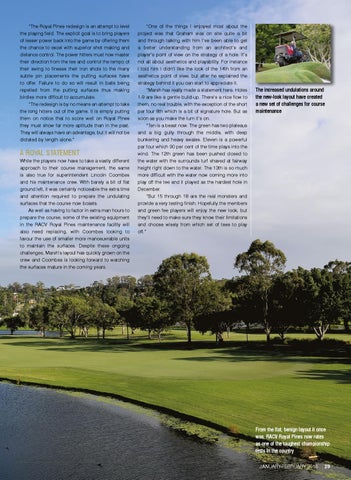“The Royal Pines redesign is an attempt to level the playing field. The explicit goal is to bring players of lesser power back into the game by offering them the chance to excel with superior shot making and distance control. The power hitters must now master their direction from the tee and control the tempo of their swing to finesse their iron shots to the many subtle pin placements the putting surfaces have to offer. Failure to do so will result in balls being repelled from the putting surfaces thus making birdies more difficult to accumulate. “The redesign is by no means an attempt to take the long hitters out of the game. It is simply putting them on notice that to score well on Royal Pines they must show far more aptitude than in the past. They will always have an advantage, but it will not be dictated by length alone.”
A ROYAL STATEMENT While the players now have to take a vastly different approach to their course management, the same is also true for superintendent Lincoln Coombes and his maintenance crew. With barely a bit of flat ground left, it was certainly noticeable the extra time and attention required to prepare the undulating surfaces that the course now boasts. As well as having to factor in extra man hours to prepare the course, some of the existing equipment in the RACV Royal Pines maintenance facility will also need replacing, with Coombes looking to favour the use of smaller more manoeuvrable units to maintain the surfaces. Despite these ongoing challenges, Marsh’s layout has quickly grown on the crew and Coombes is looking forward to watching the surfaces mature in the coming years.
“One of the things I enjoyed most about the project was that Graham was on site quite a bit and through talking with him I’ve been able to get a better understanding from an architect’s and player’s point of view on the strategy of a hole. It’s not all about aesthetics and playability. For instance I told him I didn’t like the look of the 14th from an aesthetics point of view, but after he explained the strategy behind it you can start to appreciate it. “Marsh has really made a statement here. Holes 1-9 are like a gentle build-up. There’s a nice flow to them, no real trouble, with the exception of the short par four 8th which is a bit of signature hole. But as soon as you make the turn it’s on. “Ten is a beast now. The green has two plateaus and a big gully through the middle, with deep bunkering and heavy swales. Eleven is a powerful par four which 90 per cent of the time plays into the wind. The 12th green has been pushed closed to the water with the surrounds turf shaved at fairway height right down to the water. The 13th is so much more difficult with the water now coming more into play off the tee and it played as the hardest hole in December. “But 15 through 18 are the real monsters and provide a very testing finish. Hopefully the members and green fee players will enjoy the new look, but they’ll need to make sure they know their limitations and choose wisely from which set of tees to play off.”
The increased undulations around the new-look layout have created a new set of challenges for course maintenance
From the flat, benign layout it once was, RACV Royal Pines now rates as one of the toughest championship tests in the country JANUARY-FEBRUARY 2016
29
